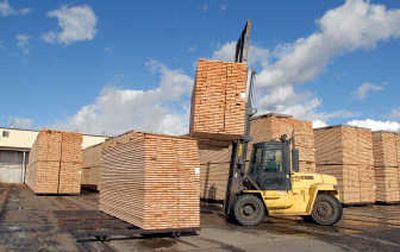Lumber prices plummet

The nation’s housing market crisis is making itself felt at Inland Northwest sawmills.
Most lumber produced here is shipped to Chicago, Denver and the East Coast, areas where new home construction is down sharply.
“Lumber demand is just really, really bad … I could use expletives to describe it,” said Andrew Miller, chief executive officer of Stimson Lumber Co., which operates three North Idaho sawmills. “Prices have dropped to levels not seen since the early 1980s.”
At Stimson’s Priest River sawmill, most of the 55 workers stayed home this past week. The company lost less money idling the sawmill than churning out lumber at a loss, Miller said. He expects Stimson’s mills to take more downtime during the winter holidays.
With demand for lumber expected to erode further in the next three to six months, “we’re in a hunker down mode,” Miller said. “In these kinds of markets, you can do some serious damage to your balance sheets.”
About 70 percent of the nation’s lumber is used in home construction and remodeling.
While prices have been sluggish all year, they took a dive in September amid more bad news about the national housing market. Random Lengths, a Eugene, Ore., newsletter that covers the forest products industry, led this week with the headline: “Downturn in prices trumps 1981 and 1991 troughs.”
“For anybody wondering whether the market is really that bad – it is,” wrote Jeff Redd, the newsletter’s associate editor. He compared prices for framing lumber to prices during the two previous economic recessions. After adjusting for inflation, prices are lower, concluded the article, which also predicted more downtime and mill closures.
The industry outlook remains fairly grim through 2008, said Kevin Binam, director of economic services for the Western Wood Products Association in Portland. “The industry follows the housing market, which is still softening,” he said.
Analysts often base predictions of lumber demand on the number of building permits issued for single-family homes. After peaking in mid-2005, the number of single-family permits has dropped each year. In September, they declined 7 percent, surprising analysts who had projected a more modest drop.
In North Idaho, about 150 fewer people worked at the region’s mills compared to a year ago. Stimson cut shifts at its Priest River mill and its DeArmond mill in Coeur d’Alene in anticipation of weaker markets. The Portland-based company also closed an Oregon mill.
Riley Creek Lumber Co. also has cut a shift at its Moyie Springs mill near the Canadian border. “It’s not profitable to operate at these levels,” said Marc Brinkmeyer, Riley Creek’s owner. “We’re in the process of reducing our hours and watching our costs.”
Lumber production west of the Cascades has plunged 16 percent since this time last year. Despite cutbacks at various mills, there’s still a glut of lumber for sale, mill owners said. “It’s like a bathtub with water pouring over the sides and running on the ground,” Miller said of inventory levels. “And the faucet’s still turned on.”